air condition LEXUS RCF 2019 Service Manual
[x] Cancel search | Manufacturer: LEXUS, Model Year: 2019, Model line: RCF, Model: LEXUS RCF 2019Pages: 636, PDF Size: 12.48 MB
Page 417 of 636

4176-3. Do-it-yourself maintenance
RC F_U 6
Maintenance and care ■
Situations in which the tire pressure warning system may not operate properly ●
In the following cases, the tire pressure warning system may not operate properly.
• If non-genuine Lexus wheels are used.
• A tire has been replaced with a tire that is not an OE (Original Equipment) tire.
• A tire has been replaced with a tire that is not of the specified size.
• Tire chains etc. are equipped.
• An auxiliary-supported run-flat tire is equipped.
• If a window tint that affects th e radio wave signals is installed.
• If there is a lot of snow or ice on the vehi cle, particularly around the wheels or wheel
housings.
• If the tire inflation pressure is extr emely higher than the specified level.
• If tires not equipped with tire pressure warning valves and tr ansmitters are used.
• If the ID code on the tire pressure warning valves and transmitters is not registered
in the tire pressure warning computer. ●
Performance may be affected in the following situations.
• Near a TV tower, electric power plant, gas station, radio station, large display, air-
port or other facility that generates st rong radio waves or electrical noise
• When carrying a portable radio, cellular phone, cordless phon e or other wireless
communication device
If tire position information is not correctly displayed due to the radio wave conditions,
the display may be corrected by driving and changing the radio wave conditions. ●
When the vehicle is parked, the time taken for the warning to start or go off could be
extended. ●
When tire inflation pressure declines rapidly for example when a tire has burst, the
warning may not function. ■
The initialization operation ●
Make sure to carry out initialization afte r adjusting the tire inflation pressure.
Also, make sure the tires are cold before carryi ng out initialization or tire inflation pres-
sure adjustment. ●
If you have accidentally turned the engine swit ch off during initialization, it is not neces-
sary to press the reset switch again as initialization will re start automatically when the
engine switch has been turned to IG NITION ON mode for the next time.●
If you accidentally press the re set switch when initialization is not necessary, adjust the
tire inflation pressure to the specified leve l when the tires are co ld, and conduct initial-
ization again. ■
When initialization of the tire pressure warning system has failed
Initialization can be completed in a few minutes. However, in the following cases, the set-
tings have not been recorded and the system will not operate properly. If repeated
attempts to record tire inflation pressure settings are unsuccessful, have the vehicle
inspected by your Lexus dealer. ●
When operating the tire pres sure warning reset switch, th e tire pressure warning light
does not blink 3 times. ●
After carrying out the initializat ion procedure, the tire pressu re warning light blinks for 1
minute then stays on after driving for 20 minutes.
Page 419 of 636

4196-3. Do-it-yourself maintenance
RC F_U 6
Maintenance and care NOTICE ■
Repairing or replacing tires, wheels, tire pressure warning valv es, transmitters and
tire valve caps ●
When removing or fitting the wheels, tires or the tire pressure warning valves and
transmitters, contact your Lexus dealer as the tire pressure warning valves and trans-
mitters may be damaged if not handled correctly. ●
Make sure to install the tire valve caps. If the tire valve caps ar e not installed, water
could enter the tire pressure warning valves and the tire pressure warning valves
could be bound. ●
When replacing tire valve caps, do not use tire valve caps other than those specified.
The cap may become stuck. ■
To avoid damage to the tire pressu re warning valves and transmitters
When a tire is repaired with liquid sealants, the tire pressure warning valve and trans-
mitter may not operate properly. If a liquid sealant is used, contact your Lexus dealer or
other qualified service shop as soon as possi ble. After use of liquid sealant, make sure
to replace the tire pressure warning valve and transmitter when repairing or replacing
the tire. ( P. 413)■
Driving on rough roads
Take particular care when driving on roads with loose surfaces or potholes.
These conditions may cause lo sses in tire inflation pre ssure, reducing the cushioning
ability of the tires. In addition, driving on rough roads may cause damage to the tires
themselves, as well as the vehicle’s wheels and body. ■
Low profile tires
Low profile tires may cause greater damage than usual to the tire wheel when sustain-
ing impact from the road surface. Ther efore, pay attentio n to the following:●
Be sure to use proper tire inflation pressu re. If tires are under-inflated, they may be
damaged more severely. ●
Avoid potholes, uneven pavement, curbs an d other road hazards. Failure to do so
may lead to severe tire and wheel damage. ■
If tire inflation pressure of ea ch tire becomes low while driving
Do not continue driving, or your tires and/or wheels may be ruined.
Page 422 of 636

422 6-3. Do-it-yourself maintenance
RC F_U ■
Instructions for checking tire inflation pressure
When checking tire in flation pressure, ob serve the following:●
Check only when the tires are cold.
If your vehicle has been parked for at least 3 hours or has not been driven for more than
1 mile or 1.5 km, you will get an accurate cold tire inflation pressure reading. ●
Always use a tire pressure gauge.
It is difficult to judge if a tire is properly inflated based only on its appearance. ●
It is normal for the tire inflat ion pressure to be higher after driving as heat is generated
in the tire. Do not reduce tire inflation pressure after driving.●
Never exceed the vehicle capacity weight.
Passengers and luggage weight should be placed so that the vehicle is balanced.
WARNING ■
Proper inflation is critical to save tire performance
Keep your tires properly inflated.
If the tires are not properly inflated, the following conditions may occur which could
lead to an accident resultin g in death or serious injury:●
Excessive wear ●
Uneven wear ●
Poor handling ●
Possibility of blowouts resu lting from overheated tires●
Air leaking from between tire and wheel ●
Wheel deformation and/or tire damage ●
Greater possibility of tire damage while driving (due to road hazards, expansion
joints, sharp edges in the road, etc.)
NOTICE ■
When inspecting and adjust ing tire inflation pressure
Be sure to put the tire valve caps back on.
If a valve cap is not installed, dirt or moisture may get into the valve and cause an air
leak, resulting in decreased tire inflation pressure.
Page 425 of 636
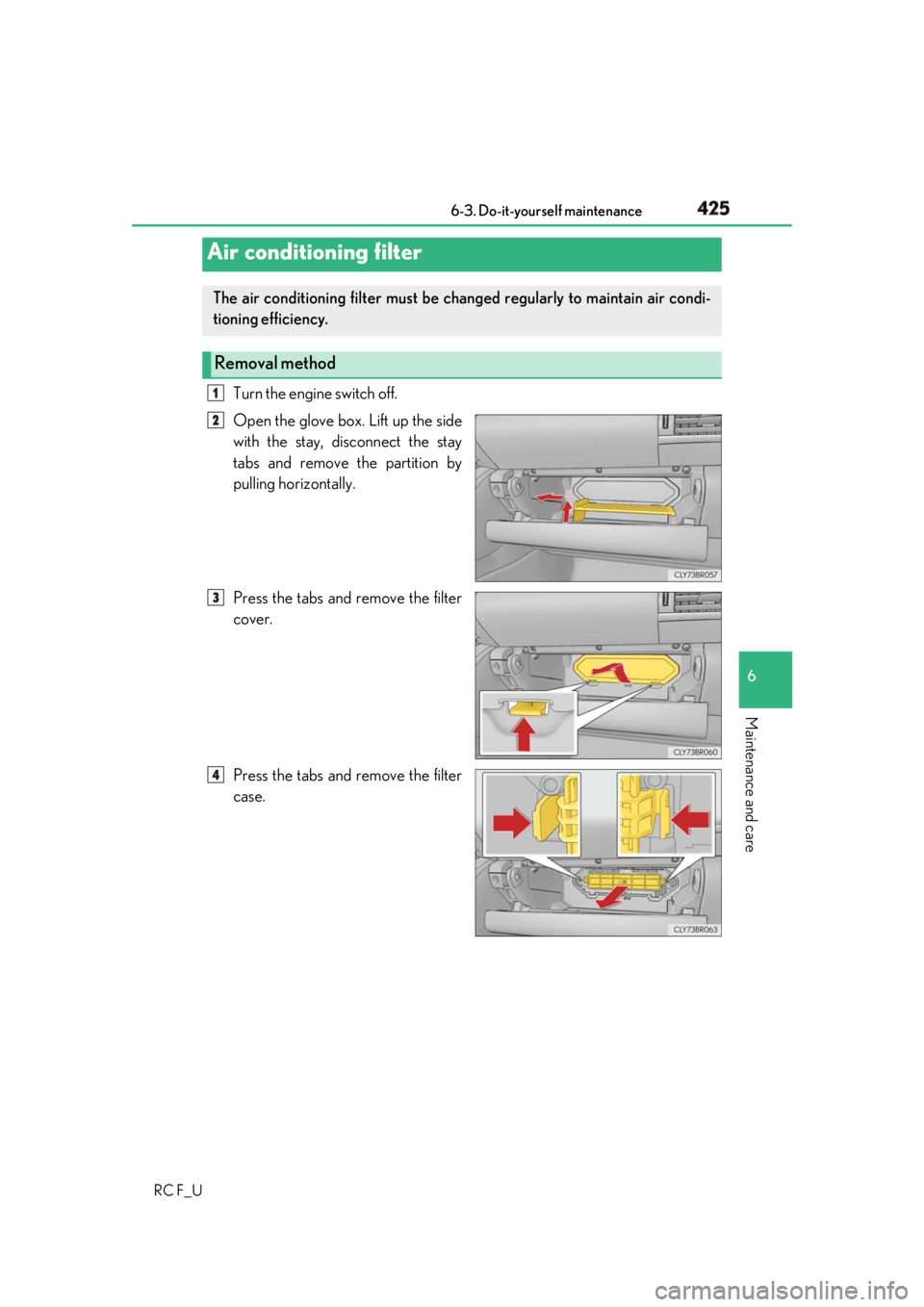
4256-3. Do-it-yourself maintenance
RC F_U 6
Maintenance and care Turn the engine switch off.
Open the glove box. Lift up the side
with the stay, disconnect the stay
tabs and remove the partition by
pulling horizontally.
Press the tabs and remove the filter
cover.
Press the tabs and remove the filter
case.Air conditioning filter The air conditioning filter must be ch anged regularly to maintain air condi-
tioning efficiency.
Removal method 1
2
3
4
Page 426 of 636
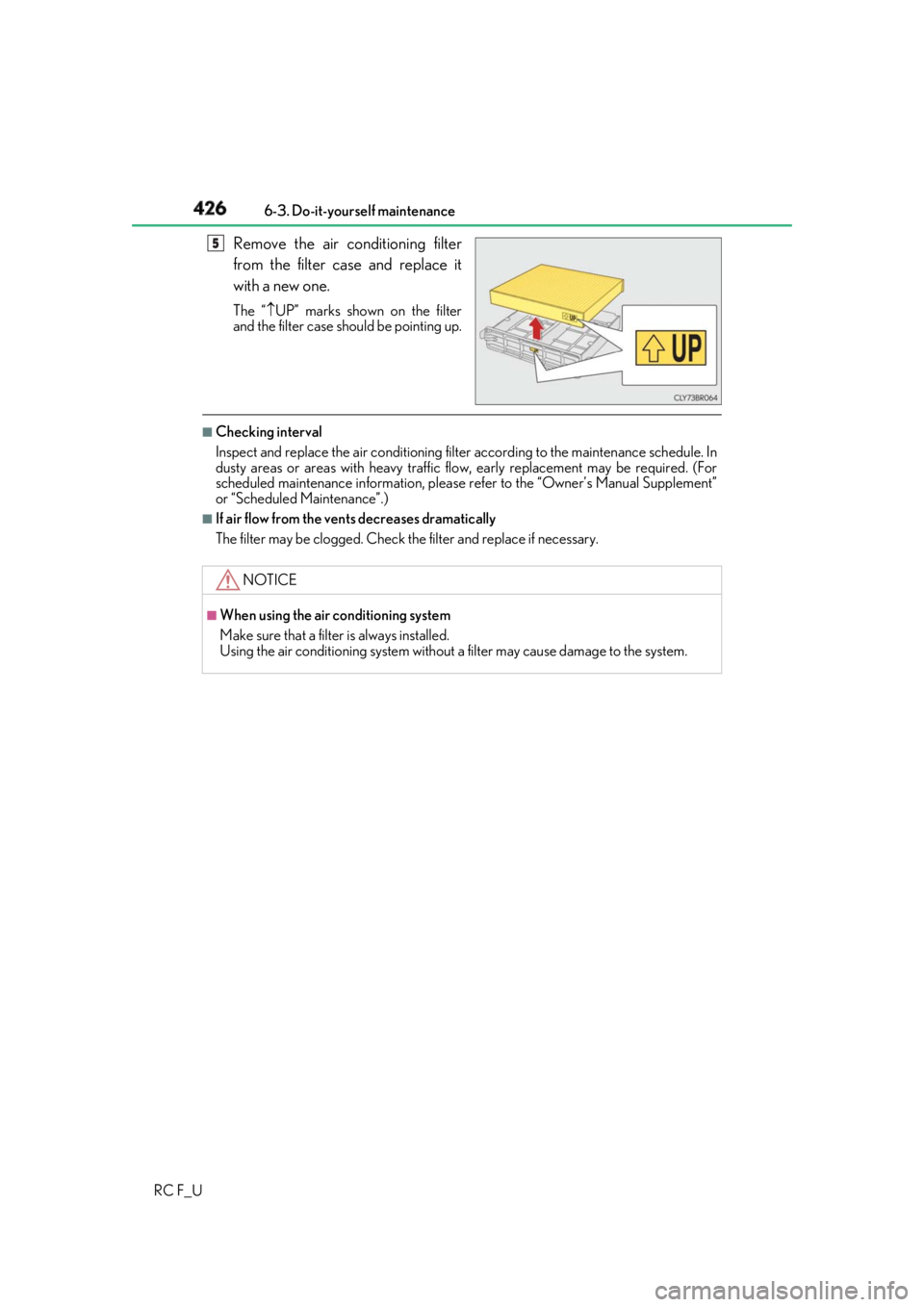
426 6-3. Do-it-yourself maintenance
RC F_U Remove the air conditioning filter
from the filter case and replace it
with a new one. The “ UP” marks shown on the filter
and the filter case sh ould be pointing up.■
Checking interval
Inspect and replace the air cond itioning filter according to the maintenance schedule. In
dusty areas or areas with heavy traffic fl ow, early replacement may be required. (For
scheduled maintenance informat ion, please refer to the “Owner’s Manual Supplement”
or “Scheduled Maintenance”.) ■
If air flow from the vents decreases dramatically
The filter may be clogged. Check the filter and replace if necessary. 5
NOTICE ■
When using the air conditioning system
Make sure that a filter is always installed.
Using the air conditioning system without a filter may cause damage to the system.
Page 457 of 636

4577-2. Steps to take in an emergency
RC F_U 7
When trouble arises ■
SRS warning light
This warning light system monitors the airbag sensor assembly, front impact sensors, side
impact sensors (door), side impact sensors (front), side im pact sensors (rear), driver’s
seat position sensor, driver’s seat belt buckle switch, front passenger occupant classifica-
tion system, “AIR BAG ON” indicator light, “A IR BAG OFF” indicator light, front passen-
ger’s seat belt buckle switch, seat belt pretensioners, airbags, interconnecting wiring and
power sources. ( P. 41) ■
Front passenger detection sensor, seat belt reminder and warning buzzer
If luggage is placed on the front passenger seat, the front passenger detection sensor
may cause the warning light to flash and the warning buzzer to sound even if a passenger
is not sitting in the seat. ■
If the malfunction indicator lamp comes on while driving
First check the following: ●
Is the fuel tank empty?
If it is, fill the fu el tank immediately.●
Is the fuel tank cap loose?
If it is, tighten it securely.
The light will go off after several driving trips.
If the light does not go off even after severa l trips, contact your Lexus dealer as soon as
possible. ■
Electric power steering system warning light (warning buzzer)
When the battery charge becomes insufficien t or the voltage temporarily drops, the
electric power steering system warning li ght may come on and the warning buzzer may
sound. ■
When the tire pressure warning light comes on
Check the tire inflation pressu re and adjust to the approp riate level. Pushing the tire
pressure warning reset switch will not tu rn off the tire pressure warning light.■
The tire pressure warning light ma y come on due to natural causes
The tire pressure warning light may come on due to natural causes such as natural air
leaks and tire inflation pressure changes caus ed by temperature. In this case, adjusting
the tire inflation pressure will turn off the warning light (aft er a few minutes).■
When a tire is replaced with the spare tire (if equipped)
The spare tire is not equipped with a tire pr essure warning valve and transmitter. If a tire
goes flat, the tire pressure warning light will not turn off even though the flat tire has been
replaced with the spare tire. ■
Conditions that the tire pressure wa rning system may not function properly
P. 417 ■
If the tire pressure warning light freque ntly comes on after blinking for 1 minute
If the tire pressure warning light frequently comes on after blinking for 1 minute when the
engine switch is turned to IGNITION ON mo de, have it checked by your Lexus dealer.■
Warning buzzer
In some cases, the buzzer ma y not be heard due to being in a noisy location or audio
sound.
Page 481 of 636
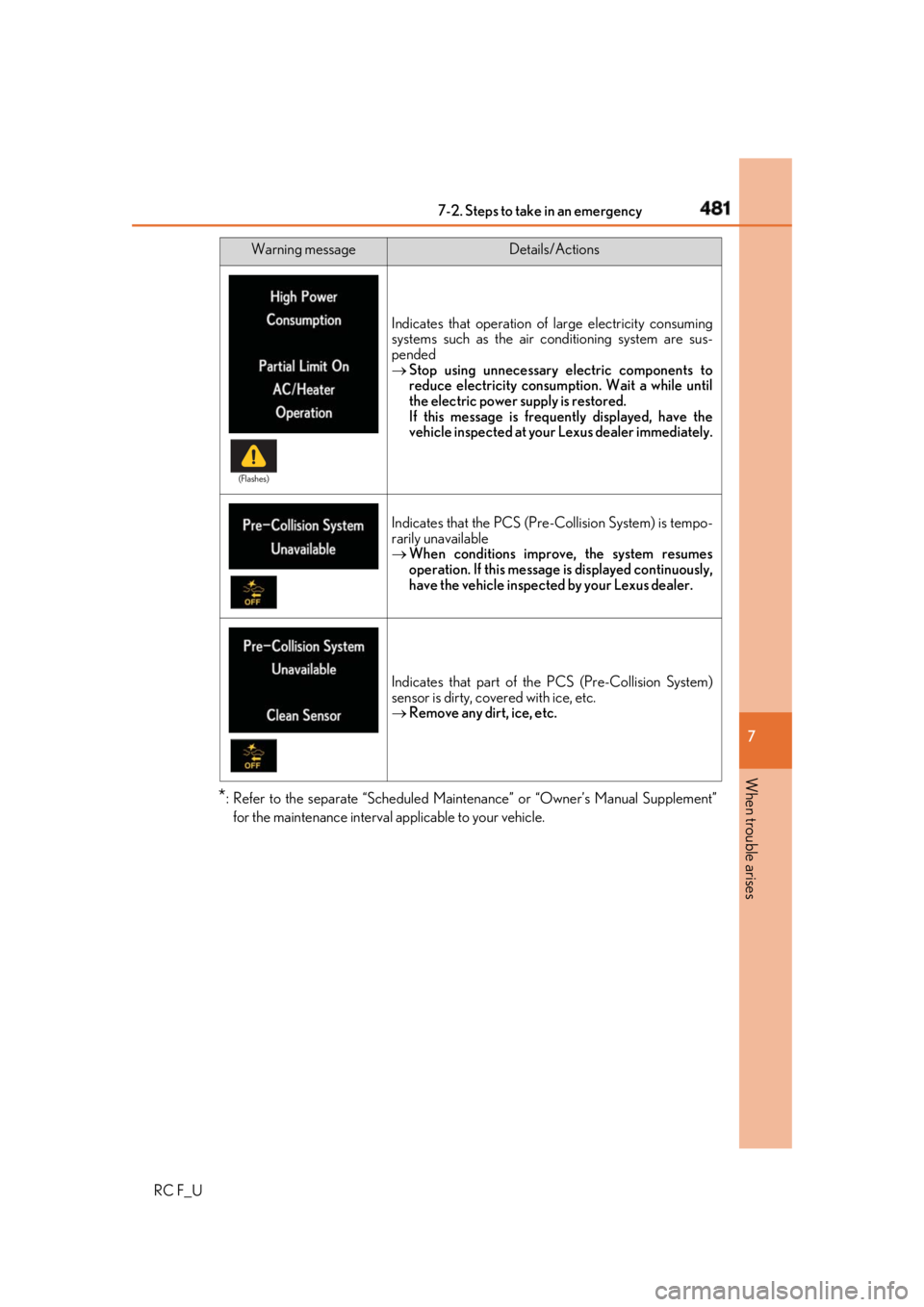
4817-2. Steps to take in an emergency
RC F_U 7
When trouble arises
* : Refer to the separate “Scheduled Mainte nance” or “Owner’s Manual Supplement”
for the maintenance interval applicable to your vehicle. Indicates that operation of large electricity consuming
systems such as the air conditioning system are sus-
pended
Stop using unnecessary electric components to
reduce electricity consumpt ion. Wait a while until
the electric power supply is restored.
If this message is freque ntly displayed, have the
vehicle inspected at your Lexus dealer immediately.
Indicates that the PCS (Pre -Collision System) is tempo-
rarily unavailable
When conditions improve, the system resumes
operation. If this message is displayed continuously,
have the vehicle inspected by your Lexus dealer.
Indicates that part of th e PCS (Pre-Collision System)
sensor is dirty, covered with ice, etc.
Remove any dirt, ice, etc.Warning message Details/Actions(Flashes)
Page 514 of 636

514 7-2. Steps to take in an emergency
RC F_U WARNING ■
When fixing the flat tire
Observe the following precautions.
Failure to do so may result in death or serious injury.●
Stop your vehicle in a safe and flat area. ●
Do not touch the wheels or the area around the brakes immediately after the vehicle
has been driven.
After the vehicle has been driven, the wheels and the area around the brakes may be
extremely hot. Touching these areas with hands, feet or other body parts may result in
burns. ●
Connect the valve and hose securely with the tire installed on the vehicle.
• If the hose is not properly connected to the valve, air leakage may occur or sealant
may be sprayed out.
• If the hose comes off the valve while inflating the tire, there is a risk that the hose
will move abruptly due to air pressure.
• After inflation of the tire has completed, the sealant may splatter when the hose is
disconnected or some air is let out of the tire. ●
Follow the operation procedure to repair the tire. If the procedure is not followed, the
sealant may spray out. ●
Keep back from the tire while it is being re paired, as there is a chance of it bursting
while the repair operation is being performed. If you notice any cracks or deforma-
tion of the tire, turn off the compressor sw itch and stop the repa ir operation immedi-
ately. ●
The kit may overheat if operated for a long period of time. Do not operate the com-
pressor continuously for more than 35 minutes. ●
Parts of the kit become hot during operation. Be careful handling the kit during and
after operation. Do not touch the metal part around the connecting area between the
bottle and compressor. It will be extremely hot. ●
Do not attach the vehicle speed warning sticker to an area other than the one indi-
cated. If the sticker is attached to an area where an SRS airbag is located, such as the
pad of the steering wheel, it may preven t the SRS airbag from operating properly.■
Driving to spread th e liquid sealant evenly●
Drive the vehicle carefully at a low speed. Be especially careful when turning and cor-
nering. ●
If the vehicle does not drive straight or you feel a pull through the steering wheel, stop
the vehicle and check the following:
• Tire condition. The tire may have separated from the wheel.
• Tire inflation pressure. If tire inflation pressure is 19 psi (130 kPa, 1.3 kgf/cm 2
or
bar) or below, this may in dicate severe tire damage.
Page 526 of 636
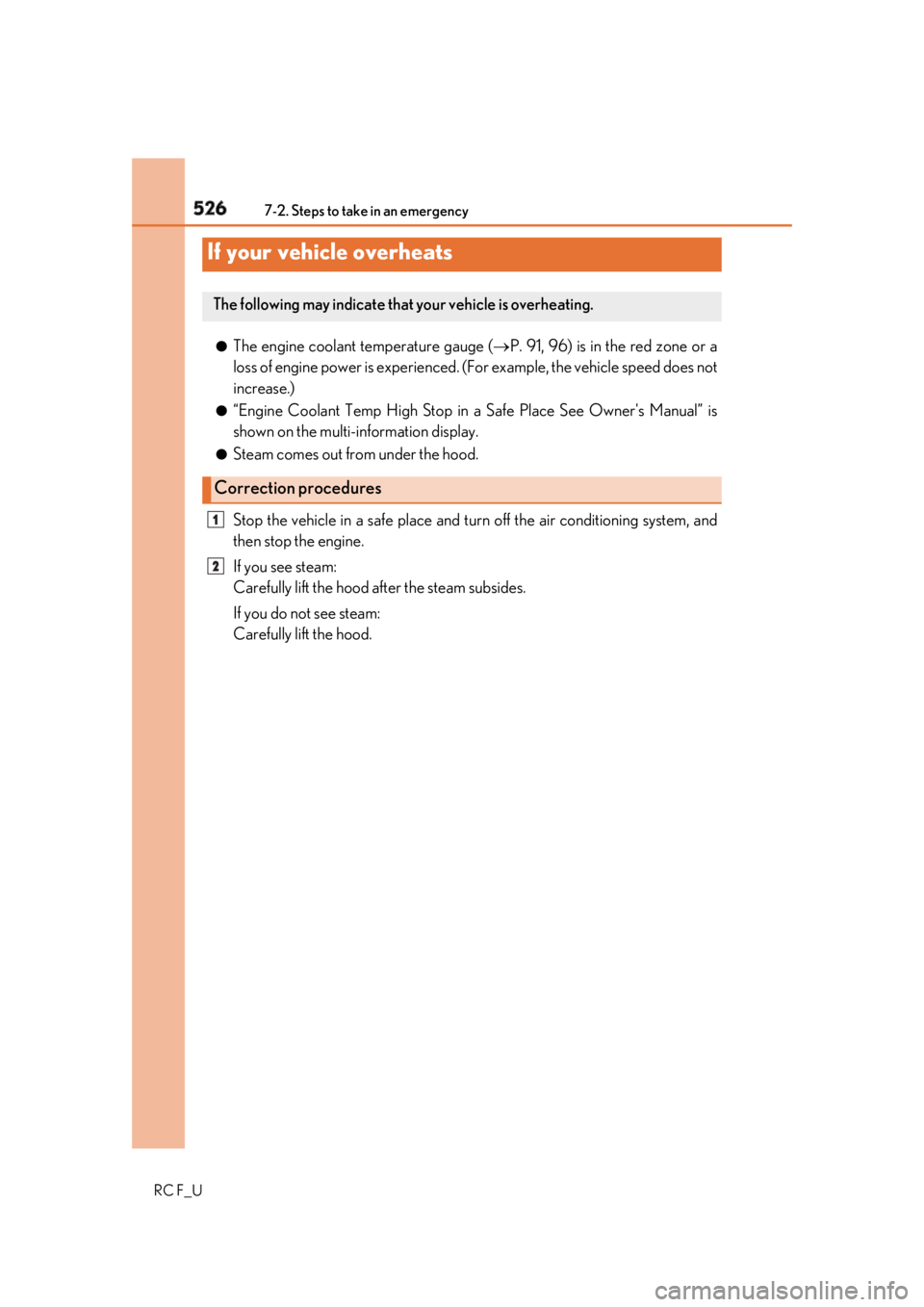
526 7-2. Steps to take in an emergency
RC F_U ●
The engine coolant temperature gauge ( P. 91, 96) is in the red zone or a
loss of engine power is experienced. (For example, the vehicle speed does not
increase.) ●
“Engine Coolant Temp High Stop in a Safe Place See Owner's Manual” is
shown on the multi-information display. ●
Steam comes out from under the hood.
Stop the vehicle in a safe place and tu rn off the air conditioning system, and
then stop the engine.
If you see steam:
Carefully lift the hood after the steam subsides.
If you do not see steam:
Carefully lift the hood.If your vehicle overheats The following may indicate that your vehicle is overheating.
Correction procedures 1
2
Page 529 of 636
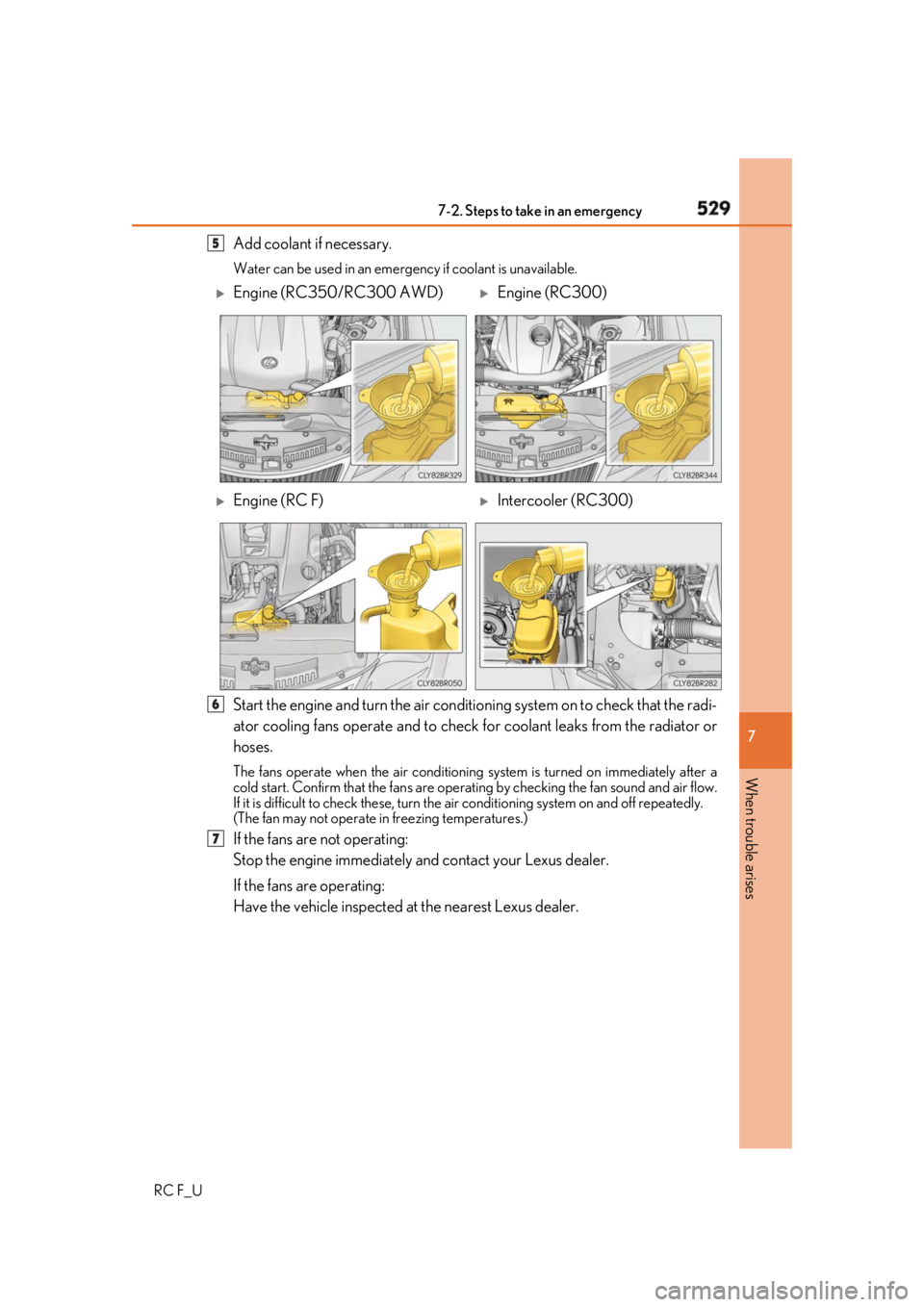
5297-2. Steps to take in an emergency
RC F_U 7
When trouble arises Add coolant if necessary. Water can be used in an emerge ncy if coolant is unavailable.
Start the engine and turn the air conditio ning system on to check that the radi-
ator cooling fans operate and to check for coolant leaks from the radiator or
hoses. The fans operate when the air conditioning system is turned on immediately after a
cold start. Confirm that the fans are operating by checking the fan sound and air flow.
If it is difficult to check these, turn the air conditioning system on and off repeatedly.
(The fan may not operate in freezing temperatures.)
If the fans are not operating:
Stop the engine immediately an d contact your Lexus dealer.
If the fans are operating:
Have the vehicle inspected at the nearest Lexus dealer. 5
Engine (RC350/RC300 AWD)
Engine (RC300)
Engine (RC F)
Intercooler (RC300)
6
7